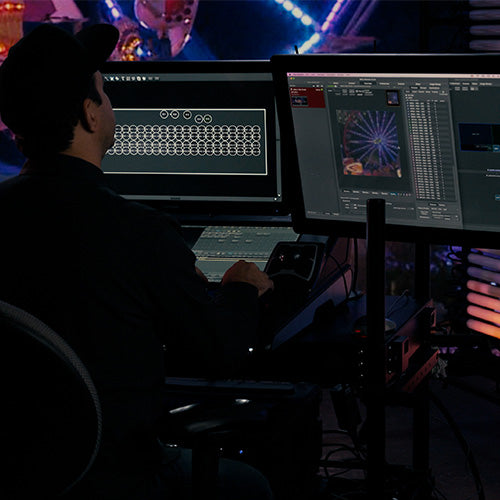How Quasar Science Solutions work with volume walls
Virtual Production and volume walls have revolutionized visual storytelling. Now, real-time digital backdrops on set, provide heightened reality and eliminate the need for green voids. However, the increased demands on lighting in virtual environments have challenged cinematographers to find new solutions.
Combining LED backings with motion picture lighting, hybrid systems bring the stunning virtual environment to life on camera. This innovative approach is helping to solve the limitations posed by the poor spectral output of volume walls, and brings the full potential of virtual production to the forefront of visual storytelling.



Image-based Lighting (IBL) transforms the way DPs, console programmers, and technicians approach set lighting. Using the same assets projected onto the volume wall, IBL creates pixel mapped lighting that adds heightened realism to the virtual set. Subtle nuances in light texture, movement, and spectral characteristics create dramatic effect, elevating the storytelling potential of virtual production. IBL is paving the way for a new level of creativity and excitement in visual storytelling, but not without some challenges that we solve with Quasar Science solutions.
Blended Sets
LED lighting in virtual production faces challenges in compatibility with volume walls and consistency in spectral output. As a new and non-standardized technology, each manufacturer's LEDs have unique characteristics, making uniformity and compatibility a challenge. Quasar Science addresses these issues with the Rainbow series to provide a problem-free workflow for LED lighting in virtual production.
IBL Profiles
Rainbow fixtures simplify virtual production with seamless integration into popular software platforms like Unreal Engine and disguise. The Rainbows transcode VRGB signals into RGBX for optimal color rendition, allowing programmers to control lighting fixtures easily and synchronize them with the digital backdrops.

RGBX
Rainbow series lights deliver optimal color rendition with their unique diode configuration. The two white diodes of different color temperature fill in the gaps in the spectral output of RGB, providing a full spectrum of light with an even distribution of wavelengths. This leads to high fidelity color representation and predictable results in virtual production. Discover more about the science behind the Rainbow series by watching the '4 Fs' episode of "The Science."

Spectrum control
With a color engine that enables spectrum control, Rainbow lights can match any other manufacturer's output for seamless integration on set. Enjoy high-fidelity color rendering and predictable results, all while having the option to downgrade the spectral output to blend in with other lights. Upgrade your virtual production game with the Rainbow 2 and Double Rainbow.
With many challenges to face on set already. Making sure your lights behave properly should not be one of them. Having lights that play well with others such as the Quasar Science Rainbow series is an asset.






